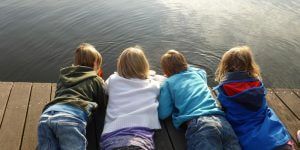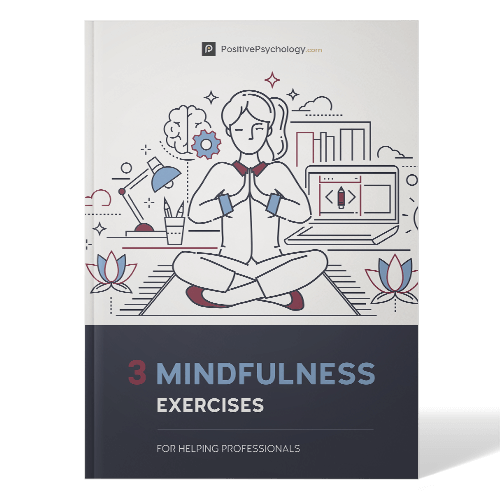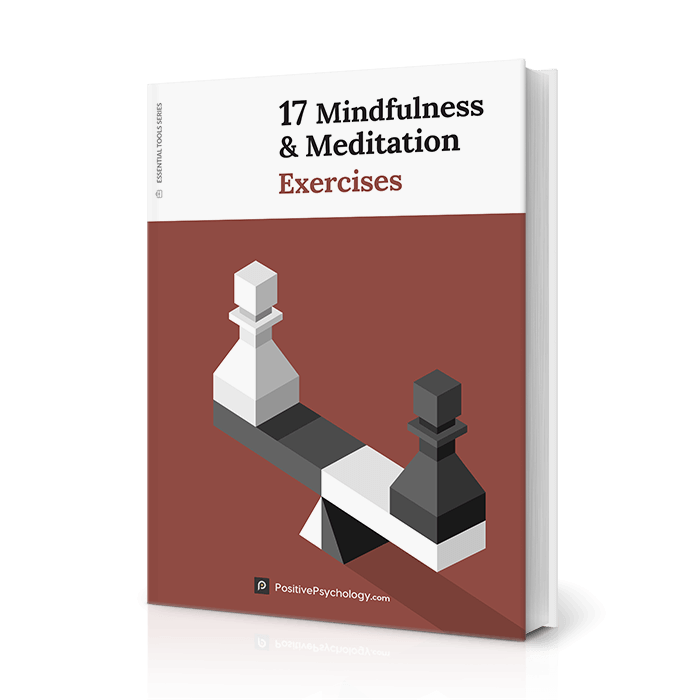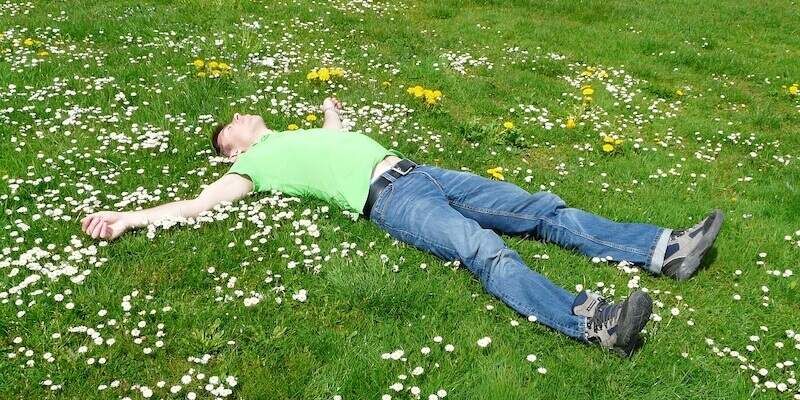18 Mindfulness Games, Worksheets and Activities for Kids
 You have probably heard about mindfulness before.
You have probably heard about mindfulness before.
After all, it’s a pretty big topic lately; even those who are not involved in the world of positive psychology have likely to at least have heard about mindfulness.
As a reminder, mindfulness is “the basic human ability to be fully present, aware of where we are and what we’re doing, and not overly reactive or overwhelmed by what’s going on around us” (Mindful Staff, 2014).
We know that mindfulness is a great tool for adults to be more relaxed, beat their stress, and improve their overall quality of life; but does this hold true for children?
Before you read on, we thought you might like to download our three Mindfulness Exercises for free. These science-based, comprehensive exercises will not only help you cultivate a sense of inner peace throughout your daily life but will also give you the tools to enhance the mindfulness of your children, clients, students or employees.
This Article Contains:
- A Mindfulness Definition for Kids
- How Can We Best Teach Mindfulness to Kids?
- What are the Benefits?
- 12 Mindfulness Activities and Exercises for Kids
- 4 Mindfulness Worksheets for Kids (Incl. PDF)
- 4 Mindfulness Meditation Scripts for All Ages
- Teaching Mindfulness to Teens
- What is Mindfulness Music for Kids and Where to Find it?
- How Toys Help Children Learn About Mindfulness
- Great Mindfulness Apps for Kids
- What is the Youth Mindfulness Program?
- 3 Videos that Explain the Concept to Kids
- 5 More Mindfulness YouTube Videos
- 6 Books to Teach Kids About Mindfulness
- 8 Mindfulness Quotes for Kids and Young Children
- A Take-Home Message
- References
A Mindfulness Definition for Kids
Mindfulness can be defined in simpler, easier-to-understand terms for children. For example, mindfulness expert David Gelles defines it as “the simple practice of bringing a gentle, accepting attitude to the present moment” (n.d.).
Children should find it easy to understand what mindfulness is based on this definition, but you might need to discuss it with them to make sure they have a good grasp on it—especially if they are young.
How Can We Best Teach Mindfulness to Kids?
As is the case for most traits, habits, and skills, the best way to instill mindfulness in children is to start early. Mindful children grow to be mindful teenagers, mindful adolescents, and mindful adults.
In addition to getting started early, it’s important to note that the very best way to teach mindfulness to your children is to practice it yourself and model it for them.
What are the Benefits?
Many of the benefits of mindfulness for children are the same as the benefits for adults, including:
- Improving physical health (e.g., reducing pain, lowering blood pressure, improving symptoms of conditions like psoriasis and fibromyalgia).
- Improving mental health (e.g., helping to address substance abuse issues, stress, anxiety, and depression, and improving sleep).
- Enhancing important social and emotional skills (e.g., the ability to feel in control, to make and maintain meaningful relationships, to accept reality, to manage difficult feelings, and to be calmer, more resilient, more compassionate, and more empathetic).
- Increasing intellectual skills (e.g., improved sustained attention, visuospatial memory, working memory, and concentration; (Weare, 2012).
However, there are some benefits specific to children, including:
- Improved cognitive outcomes (e.g., better attention and focus, higher grades).
- Improved social-emotional skills (e.g., emotion regulation, better behavior in school, higher empathy and perspective-taking, and better social skills).
- Greater well-being (e.g., lower test anxiety, lower stress, fewer posttraumatic symptoms, and less depression; Mindful Schools, n.d.).
Research and Studies
More findings are coming out on mindfulness in children all the time. Some of the latest and most influential studies on the subject have found that among other things:
- Mindfulness-based interventions for children are not only feasible, but seem promising in their impacts as well (Burke, 2009; Greenberg & Harris, 2011).
- There is preliminary evidence that mindfulness training can benefit children with anxiety, reducing their symptoms and improving their behavior (Semple, Reid, & Miller, 2005).
- Mindfulness-based cognitive therapy for children (MBCT-C) has been found to reduce symptoms of anxiety and the rate of problem behaviors in children with anxiety and attention problems (Semple, Lee, Rosa, & Miller, 2009).
- A valid and reliable measure of mindfulness in children and adolescents was developed by researchers Greco, Baer, and Smith (2011), a measure which correlates as expected with the quality of life, academic success, social skills, somatic complaints, internalizing symptoms, and externalizing behavior problems.
- Mindfulness training for children with ADHD and their parents can lead to significant reductions in parent-rated ADHD behavior, significant increases in mindful awareness, and significant reductions in parental stress and over-reactivity (van der Oord, Bögels, & Peijnenburg, 2012).
As more and more research is produced on the subject, we’ll surely hear more about the benefits and applications of mindfulness for children.
12 Mindfulness Activities and Exercises for Kids
If you’re interested in tapping into some of these benefits for your own children, you’ll probably want some tips and techniques to get them started on the right path. Read on to learn about ways you can incorporate mindfulness into your children’s daily routine.
3 Mindfulness Activities for Preschoolers and Toddlers
Breathing exercises are a great way to introduce very young children to mindfulness practice. Give one of these three breathing exercises a try with your toddler or preschooler.
1. Breathe with a Pinwheel
First, grab two pinwheels—one for yourself and one for your child. Next, follow these five steps:
- Sit with your backs straight and your bodies relaxed.
- Blow on your pinwheels together using long, deep breaths. Notice how you feel—calm and relaxed? Having trouble sitting still?
- Next, blow on your pinwheels with short, quick breaths. Notice how you feel again—do you feel the same as you did when using long, deep breaths?
- Blow on the pinwheels as you normally would. Again, notice how you feel.
- Think about the different types of breathing you engaged in, and discuss how the different breaths made you feel (Gelles, n.d.).
2. Square Breath
A square breath is a breath that is even on all sides, and it can be useful as a mindfulness exercise for both you and your child.
Here’s what to do:
- Breathe in, to the count of four.
- Hold the breath for four seconds.
- Breathe out to the count of four.
- Wait for four seconds before taking in your next breath.
To help your child keep track, show them how to draw a square in the air with their finger, taking four seconds on each side (Roman, n.d.).
3. Darth Vader Breath
This fun breathing exercise will keep your child engaged and interested.
Follow these steps to give it a try:
- Breathe in deeply through your nose.
- Keep your mouth closed and exhale from the back of your throat, making a “Darth Vader”-style noise as you do.
- Show your child how to do it, then practice it with them.
This simple exercise will help your child focus on their breath and stay fully anchored in the present (Roman, n.d.).
To learn more about activities you can incorporate into your curriculum, check out this resource from Mindful Moments in Education.
4 Tips to Teach Mindfulness in Kindergarten
If you’re looking to teach mindfulness to children in your kindergarten class (or to children around kindergarten age), try these four tips:
- Bring a stuffed animal friend with you to match a mindfulness meditation script (e.g., if you have a script about a bunny, bring a stuffed bunny).
- Use a video to keep your kids engaged in learning about mindfulness.
- Integrate nature into the practice of mindfulness; take students outside and relate the exercises to things in nature (e.g., “Sit up straight like a tall tree”).
- Keep timing in mind; keep mindfulness exercises short and sweet and plan them for times when your students may have a bit less energy (Counselor Keri, 2018).
5 Mindfulness Games for Kids
These five games from Chris Bergstrom (2017) at BlissfullKids.com provide you with an excellent opportunity to introduce your children to mindfulness and help them practice it.
1. Balancing on One Foot
This exercise is for children 3 and up, and all you need for it is your body!
Here’s what to do:
- Tell your child to focus her gaze slightly below eye level.
- Tell her to stand on one leg and keep her gaze fixed on that focal point.
- Challenge her to see how long she can stand on one leg like this.
- Tell her to try the other leg.
- Challenge her to stay focused while you engage her in conversation, ask her to sing a song, or tell her to close her eyes.
This is a simple game that can help your child develop her focus and improve her body awareness as well as giving her a chance to practice mindfulness.
2. Jenga
Have you ever played Jenga? If so, you know that it can be a lot of fun but that it also requires concentrated attention and awareness. Take advantage of that fact and use Jenga to build your child’s mindfulness.
To make the game into an exercise, play two ways:
- First, play the game while your child is distracted. Allow his mind to wander and engage him in conversation or activities that take away from his focus on the game.
- Next, help your child cultivate a calm and clear mind through mindful breathing, and play again.
After you play the distracted version, engage your child in a discussion about it; does he know what made him lose focus? Did certain thoughts or emotions distract him and ruin his concentration?
After you play the calm and clear-minded version, discuss again; did he have an easier time paying attention? Did the mindful breathing contribute to better focus?
This game will help your child see the advantages of being mindful and encourage him to work on his own mindfulness.
3. Pennies Game
This game is good for children 3 and up and can be played one-on-one or with a group. All you’ll need to play is a penny for each player and a basket.
Here’s how to play:
- Give everyone a penny and allow them one minute to study it, focusing on the details.
- Put all the pennies in the basket.
- Have each player pick their penny out of the basket.
- Once a player chooses their penny from the basket, have them explain how they knew it was their penny.
The penny game can be played with other objects too; the important part is that the children playing are able to focus in on something and pay attention to detail.
4. Balancing Relay
The balancing relay game is good for children 5 and older. If you’ve ever seen or participated in an egg and spoon race, you’ll recognize this game.
You will need a spoon and some water or a spoon and a potato for each team playing.
Split your group into teams (two teams might work best, but you can always do a few smaller teams) and give a spoon full of water to each team. Challenge them to carry their spoon to the next person on their team without spilling any of the water.
To make it even more difficult for older children, have them walk backward or sideways instead of forward.
This game will encourage your children to develop greater awareness, enhance their focus, and stay grounded in the present moment and in their own body.
5. Simon Says
An old classic, this game can help children practice mindful seeing, mindful listening, and greater awareness. It’s good for children 4 and up and all you need is some space to move around in.
Here’s how to play Simon Says:
- Designate a “Simon” to lead everyone (it might be best for an adult to play Simon first).
- Simon stands in front of the other players and instructs them to do physical movements (e.g., touch your nose, balance on one foot).
- The players should only do what Simon instructs them to do if he or she says “Simon says” at the beginning.
- If a player follows one of Simon’s instructions that is not prefaced by “Simon says,” he or she is eliminated from the game.
- The last player standing wins.
Once you finish the game, talk to your child(ren) about how hard or easy it was to follow the instructions and pay attention to the “Simon Says” at the beginning. Discuss the importance of paying attention and being present.
4 Mindfulness Worksheets for Kids (Incl. PDF)
While children generally appreciate opportunities to play games and practice fun exercises more than filling out worksheets and answering written questions, there are some helpful worksheets that can both keep them engaged and encourage them to be more mindful.
These are intended for older children, but younger children with particularly good focus might benefit from them as well.
1. Mindful or Unmindful
This worksheet is easy to use and provides children with some ideas for ways that they can act more mindfully.
The only instructions are to read the actions and decide which are mindful and which are not. The actions include:
- Leaving your jacket on the floor when you come in from outside.
- Keeping your voice quiet when other people are reading.
- Helping someone that is hurt or scared.
- Crossing the street without looking.
- Letting someone finish talking before answering.
- Practicing a new skill like sports or music until you feel your body improving.
As an added bonus, the worksheet can also be used for coloring, offering children an opportunity to practice even more mindfulness.
Click here to see the worksheet, or here to download it.
2. The Present Moment
This worksheet opens with a definition of what it means to be present or mindful: “The word ‘present’ can mean a gift, and it also describes what is happening right now, in the moment.”
Next, there are instructions on how to complete the rest of the worksheet: “Sit quietly and pay attention to what is going on right now using your five senses. Reflect on what you experience below.”
There are five sections to fill out based on the five senses:
- Right now I see…
- Right now I hear…
- Right now I am touching…
- Right now I smell…
- Right now I feel…
This is a great way for children to work on becoming more present, a vital practice for encouraging mindfulness.
Click here to see the worksheet from Education.com.
3. Mindful Listening
This worksheet guides children through listening “like an owl,” and becoming more aware of the sounds around them.
Here are the instructions: “Listen like an owl to become more aware of the sounds around you. An owl can hear sounds that are close up and far away, and can also be silent when needed. Go on a ‘sound hunt’ as an owl. What do you hear close up? What do you hear far away? Write and draw your observations.”
The worksheet is a simple one, with lots of space for noting the sounds your child hears and drawing what they hear.
You can find this worksheet here.
4. Mindful Movement
Another worksheet from Education.com, this one will walk your child through moving mindfully.
Although children may have a hard time pairing mindfulness with movement, especially when they are first learning about mindfulness, the two are certainly not mutually exclusive. The worksheet helps your child learn about moving mindfully by instructing them to act like a deer this time.
The instructions are as follows: “Sometimes when we want to be mindful we are still. We can also be mindful when we move. Practice walking like a deer. Move slowly and deliberately, with purpose, and pay attention to where you are going. Practice pausing in stillness, as though you are camouflaged.”
Next, your child will answer a few questions about their mindful movement practice:
- What does it feel like to walk like a deer?
- What does it feel like to be still/camouflaged like a deer?
- Describe a time when you can walk mindfully.
- Describe a time when you can use stillness or camouflage.
If your child enjoys the first page, they can also turn to the second page for more mindful movement. On this page, they choose another animal to practice moving and remaining still, then they have the opportunity to draw themselves walking as this animal.
You can find this worksheet here.
For more resources on teaching mindfulness to children, check out this handout from TherapistAid.com.
4 Mindfulness Meditation Scripts for All Ages
These mindfulness meditation scripts from MindfulnessExercises.com are intended for adults, but can easily be used by older children or as a template you can customize for your child.
1. Body Scan Script
This script walks you through a classic mindfulness meditation called the “body scan.” As you might guess, it involves doing a mental scan of your body to note any areas where you are holding on to tension or storing your stress.
You will start with cultivating awareness through your breath, then you will move to your head, face, neck, and shoulders. Next, you will move down to your arms and hands, and continue until you reach your feet. As you go, you will notice how your body feels in each area.
At the end, ask yourself this reflection question: “What information do you receive when checking in with your body?”
You can find this script here.
2. Two Minutes of Mindful Breathing
This quick script will help you use your breath to boost your awareness and cultivate greater mindfulness.
You will start with a full breath in and a long breath out, then counting through your breath, and finally observing the way your body feels as you breathe—how your chest rises and falls, how it feels to take air in through your nose, etc.
To make this exercise even more impactful, you can follow the instructions at the end to make it a journaling experience; the prompts are:
- What I want from this 28-day challenge is…
- Some obstacles to me practicing every day could be…
Click here to read through this script.
3. Mindfulness of Anger
This script is a useful one for anyone struggling with anger. As such, it’s a great choice for children who are having behavioral problems or lashing out, although you may need to tweak it a bit to make it relevant and appropriate for children.
The script will walk you through bringing yourself to greater awareness, being present in your body, breathing mindfully, finding your anger, and allowing yourself to express it, let go of it, or both.
To read the whole script, click here.
4. Self-Compassion
If you want to help your child build their self-compassion, this script is a great place to start. It is a version of the popular “loving-kindness” variety of meditation that is particularly focused on cultivating compassion for the self.
It opens with the usual mindfulness meditation practices: improving awareness, becoming present, checking in with your body, and breathing mindfully.
Next, it guides you through identifying a mistake, a failure, or a part of your personality that you don’t feel great about. It shows you how to accept the emotions that come with it and allow them to simply be, without fighting them.
Finally, this script will walk you through giving yourself a break and offering yourself love and understanding. Towards the end, you will repeat some phrases or mantras to help you appreciate yourself, including “May I be safe. May I be peaceful. May I be kind to myself. May I accept myself as I am.”
You can find this script here, and access more scripts and other mindfulness exercises here.
Teaching Mindfulness to Teens
There is a lot more flexibility when teaching mindfulness to teens vs. teaching mindfulness to younger children. The five simple exercises below offer a good opportunity to allow your teenager to try mindfulness on their own. These exercises come from D’Arcy Lyness at KidsHealth.org.
5 Mindfulness Exercises and Activities for Teens
1. Mindful Eating
In this exercise, your teen will learn how to eat mindfully. The example used is an orange, but it can be almost anything.
Here’s what to do:
- Start by holding your orange and rolling it in your hand, noticing how it feels.
- Hold the orange close to your nose and take a sniff. Think about what it smells like.
- Pay attention to what it looks like and what it feels like.
- Peel your orange mindfully, and stay present.
- Taste the orange, noting the flavor, the texture, the juiciness, etc.
2. Mindful Breathing
Mindful breathing is another simple exercise your teen can try. He or she will focus on breathing, but refrain from forcing themselves to breathe in a certain way.
Have your teen follow these steps:
- Sit in a comfortable position and close your eyes.
- Breathe normally and notice how it feels; pay attention as the air goes in and out of your lungs.
- Notice how your breath moves your body; does your chest and/or your belly rise and fall as you breathe?
- Sit for a few minutes, paying attention to your breathing, and become as relaxed as you can be.
- If your mind starts to wander from the task at hand, gently guide it back to your breath.
3. Mindful Walking
Mindful walks are great ways to practice and maintain mindfulness in your everyday life, and your teenager will likely feel the same.
Guide them through these four easy steps:
- Pick up one foot and take a slow-motion step forward. Notice what you have to do to stay balanced.
- Walk in slow motion, one step at a time. Pay attention to how your arms, legs, and feet move as you walk.
- Breathe in and out in time with your steps. Stay relaxed but keep your attention focused on your breath and your steps, working in tandem.
- If your mind starts to wander, bring it gently back to your slow-motion walking.
4. Mindful Word
This exercise instructs you to choose a word that connects back to mindfulness and use it as an anchor to keep you present, calm, and collected. Teenagers should find it easy to follow and helpful in maintaining their mindfulness.
Here are the steps:
- Think of a word that seems calm or soothing to you, like “peace”, “love”, “sunlight”, or “calm.”
- Think the word to yourself, saying it silently in your own mind. Say it again as you breathe, once when you breathe in and once when you breathe out. Stay focused on the word.
- If/when your mind begins to wander, gently bring it back to your word.
- Challenge yourself to do this for one minute. If that seems too easy, try five minutes!
5. Mindful Driving
This is a great exercise for teenagers because it will not only help them become more mindful, it can also encourage them to be better and safer drivers.
Here’s how it works:
- Take a moment before you start the car to cultivate greater awareness. Think about how it feels to sit in the driver’s seat right now.
- Take one slow, deep breath as you settle into your seat. Make sure you are comfortable and you can easily reach the pedals. Adjust your seat if necessary.
- Fasten your seat belt and say to yourself, “I plan to pay attention while I’m driving. I plan to drive safely and well.”
- Shift your attention to the mirrors, checking to make sure they are in the right position and adjusting them if they are not.
- Take another slow, deep breath and start the car. Expand your awareness to the area directly around the car, looking for people, other cars, or anything else that could be an obstacle.
- As you drive, pay attention to any of the many situations that require you to slow down or speed up. Keep your attention focused on your driving and the situations around you.
- If you feel distracted or find your mind wandering, remind yourself that you are driving and refocus on the task at hand.
Click here to see these five exercises explained in detail.
What is Mindfulness Music for Kids and Where to Find it?
Mindfulness music is exactly what it sounds like—it’s music that is intended to help you relax, meditate, stay mindful, and stay calm and cool-headed.
There are tons of mindfulness music videos out there that you can use with your children. Here are just a few examples:
Relax Music for Children – Stress Relief, Study Music, Sleep Music, Meditation Music from Mindful Kids
Morning Relaxing Music for Children – Childhood Memories (Hayfield) from OCB Relax Music
To find more, simply search for “mindfulness music for kids” on Google or YouTube.
How Toys Help Children Learn About Mindfulness
There are many toys available that can help children learn about mindfulness, cultivate mindfulness, and practice and maintain that mindfulness.
Some of these toys, like the mindfulness bear described below, are newer toys designed specifically for boosting mindfulness, but many “classic” toys can also help to boost mindfulness in children.
These toys include:
- Kites
- Spinning tops
- Cards
- Dominoes
- Kaleidoscopes
- Handheld ball mazes (Schwartz, n.d.)
Each of these toys can capture a child’s attention and keep them grounded in the present—batteries not required!
The Mindfulness Bear
If you’re looking for a toy that was designed to help your child be more mindful, the mindfulness bear might be just what you’re looking for.
This fuzzy guy is called Max Mindpower, and not only is he cute and cuddly—he can help your child develop and maintain their mindfulness! He comes packed with three guided meditations (body scan, mindfulness of breathing, and kindly awareness), one neuro-linguistics exercise for children, and an introductory rhyming book.
Can Video Games Help Encourage Mindfulness?
It might seem counterintuitive, but video games can actually boost mindfulness in children. It depends on the video game and how it is being played, of course, but there is potential for greater mindfulness through three mechanisms:
- Video games train our brains to stay focused and regulate our attention, just like meditation does.
- Visual training through video games has effects that are similar to meditating, allowing us to tune out visual distractions and focus on the important things.
- Video games teach us how to regulate our emotions; since getting too angry or frustrated sets us up for failure, we must learn how to deal with these emotions to succeed in our video games (Trunk, 2015).
Video games may not be the best way to teach mindfulness, but don’t cross it off your list of possibilities!
Great Mindfulness Apps for Kids
There are tons of mindfulness apps out there to help you become more mindful, and many of these apps are designed specifically for kids.
Here’s a list of 15 such apps that can help kids deal with anxiety and stress and become more mindful:
- Breathe, Think, Do Sesame
- Calm
- DreamyKid
- Headspace: Guided Meditation and Mindfulness
- Kids Yoga Deck
- Stop, Breathe, and Think Kids
- Breathing Bubbles
- Smiling Mind
- Positive Penguins
- Calm Counter
- Emotionary
- Take a Chill
- Chill Outz
- Super Stretch Yoga
- Relax Melodies
Meet the Mindful Yeti
Another app that is specially designed for building mindfulness in children is a fun one centered on an engaging mascot: the Mind Yeti. The Mind Yeti guided kids and “their adults” through mindfulness sessions that can help them boost their mindfulness and prepare for whatever comes their way.
Here’s what the app can help your child(ren) do:
- De-stress, relax, and calm down.
- Find a way to get along through practicing gratitude, empathy for others, and kindness towards themselves.
- Get more out of study time by improving their focus.
- Relax at the end of the day and fall asleep easier.
There is a free version of the app as well as a premium version with several options. You can learn about these options or sign up for the free version here.
What is the Youth Mindfulness Program?
If you’re interested in learning more about instilling mindfulness in children, you should check out the Youth Mindfulness Program.
The program is offered by the nonprofit Youth Mindfulness, a charity that is devoted to boosting mindfulness in children, adolescents, and young adults. The One Year Youth Mindfulness Program is “an in-depth comprehensive learning experience, training practitioners to teach mindfulness from a place of compassion, authenticity, and confidence.”
The program helps participants learn how to:
- Embody mindfulness in day-to-day life.
- Cultivate self-compassion, joy, and kindness.
- Develop insight into their own minds.
The Youth Mindfulness Program is guided by four main themes:
- Discovering embodiment
- Transforming and healing
- Cultivating insight
- The art of facilitation
To learn more about this program, how it works, and how you can get involved, click here.
3 Videos that Explain the Concept to Kids
To teach your children about mindfulness, you might want to try a video. Videos can be more engaging than simply listening to someone talk about a topic, and mindfulness is no exception.
These three videos can help you teach your kids about mindfulness:
The Listening Game – Cosmic Kids Yoga
Teaching Mindfulness to Children at Home and in Schools – GoStrengthsOnline
Mindfulness for Kids: What Does Being Present Mean? – Fablefy – The Whole Child
5 More Mindfulness YouTube Videos
If you’re looking for exercises and activities that your child can follow along with, there are also many helpful videos for this purpose.
Here’s a small sample of the videos that you can show your child to help them practice mindfulness:
Mindfulness for Kids – Loving Kindness Practice from Fablefy – The Whole Child
Mindfulness Meditation for Kids Breathing Exercise – New Horizon – Meditation & Sleep Stories
5 Minutes Bodyscan Meditation for Classrooms and Students – Fablefy – The Whole Child
Peace Out Guided Relaxation for Kids – Cosmic Kids Yoga
Mindful Eating: Mindfulness Exercise for Kids with Chocolate – GoStrengthsOnline
6 Books to Teach Kids About Mindfulness
If you want a book you can give your child or read with your child to encourage greater mindfulness, you’re in luck—there are many books for you to choose from.
Here’s a sample of some of the most popular ones:
- Ultimate Mindfulness Activity Book: 150 Playful Mindfulness Activities for Kids and Teens (and Grown-Ups too!) – Christian Bergstrom (Amazon)
- Mindfulness for Kids: 30 Fun Activities to Stay Calm, Happy, and In Control – Carole P. Roman and J. Robin Albertson-Wren (Amazon)
- Mindful Kids: 50 Mindfulness Activities for Kindness, Focus, and Calm – Whitney Stewart and Mina Braun (Amazon)
- Breathe Like a Bear: 30 Mindful Moments for Kids to Feel Calm and Focused Anytime, Anywhere – Kira Willey and Anni Betts (Amazon)
- I Am Peace: A Book of Mindfulness – Susan Verde and Peter H. Reynolds (Amazon)
- Sitting Still Like a Frog: Mindfulness Exercises for Kids (and Their Parents) – Eline Snel and Jon Kabat-Zinn (Amazon)
8 Mindfulness Quotes for Kids and Young Children
Like adults, children can use quotes to help them further their understanding and stay focused on their goals. To help your child appreciate the power of mindfulness, try sharing and discussing these quotes with them.
Mindfulness isn’t difficult, we just need to remember to do it.
Sharon Salzberg
Be where you are, otherwise you will miss your life.
Buddha
Mindfulness means being awake. It means knowing what you are doing.
Jon Kabat-Zinn
In the end, just three things matter: How well we have lived. How well we have loved. How well we have learned to let go.
Jack Kornfield
Respond; don’t react. Listen; don’t talk. Think; don’t assume.
Raji Lukkoor
Sometimes the most important thing in a whole day is the rest we take between two deep breaths.
Etty Hillesum
Life is a dance. Mindfulness is witnessing that dance.
Amit Ray
As long as you are breathing there is more right with you than wrong with you.
Jon Kabat-Zinn
A Take-Home Message
I hope you take this message home from this article: mindfulness is a vital skill for children, and there are tons of ways to go about boosting it!
What are your thoughts on cultivating mindfulness in children? Do you have any other exercises, activities, or games that you use to teach children how to be mindful? If so, feel free to share them in the comments section.
Thanks for reading and best of luck in teaching your children to be more mindful!
We hope you enjoyed reading this article. Don’t forget to download our three Mindfulness Exercises for free.
- Bergstrom, C. (2017). 5 mindful games – mindfulness for kids and teens. Blissful Kids. Retrieved from https://blissfulkids.com/mindful-games-mindfulness-for-kids-and-teens/
- Burke, C. A. (2009). Mindfulness-based approaches with children and adolescents: A preliminary review of current research in an emergent field. Journal of Child and Family Studies, 19, 133-144.
- Counselor Keri. (2018). 4 strategies for teaching mindfulness in kindergarten. Counselor Keri: Resources to Spark Student Growth! Retrieved from https://www.counselorkeri.com/2018/10/01/mindfulness-for-kindergarten/
- Gelles, D. (n.d.). Mindfulness for children. The New York Times. Retrieved from https://www.nytimes.com/guides/well/mindfulness-for-children
- Greco, L. A., Baer, R. A., & Smith, G. T. (2011). Assessing mindfulness in children and adolescents: Development and validation of the child and adolescent mindfulness measure (CAMM). Psychological Assessment, 23, 606-614.
- Greenberg, M. T., & Harris, A. R. (2011). Nurturing mindfulness in children and youth: Current state of research. Child Development Perspectives, 0, 1-6.
- Lyness, D. (2017). Mindfulness exercises. Kids Health. Retrieved from https://kidshealth.org/Nemours/en/teens/mindful-exercises.html
- Mindful Schools. (n.d.). Research on mindfulness. MindfulSchools.org. Retrieved from https://www.mindfulschools.org/about-mindfulness/research/
- Mindful Staff. (2014). What is mindfulness? Mindful.org. Retrieved from https://www.mindful.org/what-is-mindfulness/
- Roman, K. (n.d.). 5 easy breathing techniques to calm your kid (and relax the whole family). Mind Body Green. Retrieved from https://www.mindbodygreen.com/0-24120/5-easy-breathing-techniques-to-calm-your-kid-and-relax-the-whole-family.html
- Schwartz, S. (n.d.). How old-school toys can help our kids practice mindfulness. Motherly. Retrieved from https://www.mother.ly/life/old-school-toys-help-children-with-mindfulness
- Semple, R. J., Lee, J., Rosa, D., & Miller, L. F. (2009). A randomized trial of mindfulness-based cognitive therapy for children: Promoting mindful attention to enhance social-emotional resiliency in children. Journal of Child and Family Studies, 19, 218-229.
- Semple, R. J., Reid, E. F. G., & Miller, L. (2005). Treating anxiety with mindfulness: An open trial of mindfulness training for anxious children. Journal of Cognitive Psychotherapy: An International Quarterly, 19, 379-392.
- Trunk, P. (2015). Video games teach mindfulness—even Call of Duty! Penelope Trunk – Education. Retrieved from http://education.penelopetrunk.com/2015/05/06/video-games-teach-mindfulness-even-call-of-duty/
- van der Oord, S., Bögels, S. M., & Peijnenburg, D. (2012). The effectiveness of mindfulness training for children with ADHD and mindful parenting for their parents. Journal of Child and Family Studies, 21, 139-147.
- Weare, K. (2012). Evidence for the impact of mindfulness on children and young people. The Mindfulness in Schools Project. Retrieved from https://mindfulnessinschools.org/wp-content/uploads/2013/02/MiSP-Research-Summary-2012.pdf
Let us know your thoughts
Read other articles by their category
- Body & Brain (49)
- Coaching & Application (57)
- Compassion (26)
- Counseling (51)
- Emotional Intelligence (24)
- Gratitude (18)
- Grief & Bereavement (21)
- Happiness & SWB (40)
- Meaning & Values (26)
- Meditation (20)
- Mindfulness (45)
- Motivation & Goals (45)
- Optimism & Mindset (34)
- Positive CBT (28)
- Positive Communication (20)
- Positive Education (47)
- Positive Emotions (32)
- Positive Leadership (18)
- Positive Parenting (4)
- Positive Psychology (33)
- Positive Workplace (37)
- Productivity (16)
- Relationships (46)
- Resilience & Coping (36)
- Self Awareness (21)
- Self Esteem (38)
- Strengths & Virtues (32)
- Stress & Burnout Prevention (34)
- Theory & Books (46)
- Therapy Exercises (37)
- Types of Therapy (64)






What our readers think
Great resources so meaningful and thoughtful put together. Thanks you ,i shall put it to practise and share too. Red balloon relaxation is really a good idea for kids to
get the feelings and to learn about their body .it improves the behaviour too.
Hi Sue,
Glad to hear you enjoyed the read. I hope these activities work well for you in practice, too!
– Nicole | Community Manager
We have been doing the cosmic kids yoga on You tube!
What great resources!! So thoughtfully put together. Thank you. I shall put it to practice and share too
Great post I will certainly implement some of these suggestions into my ESL classes here in Italy… so important to practice mindfulness… so much garbage in the world…thanks for putting all this together… wonderful resources….
Hello Carole,
Ashish here from India.
Would you like to share the content of your ESL class please?
Thanks
Great resource for children. Thank you
Great references, thanks so much!
What a great webpage. Thank you….Would love to have more info. for high school age students dealing with anxiety and stress.